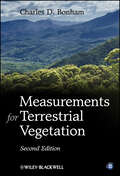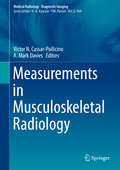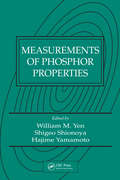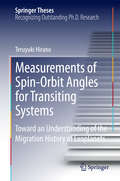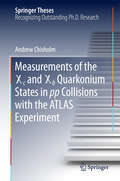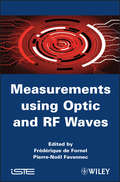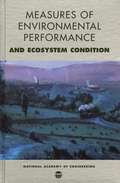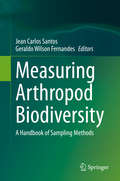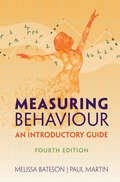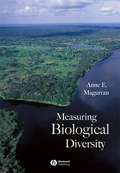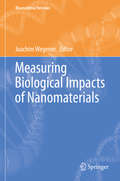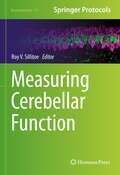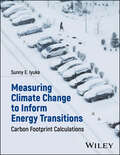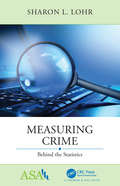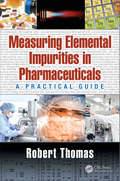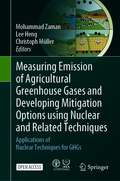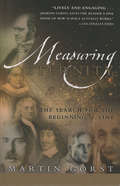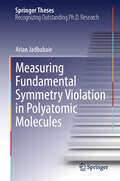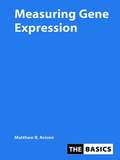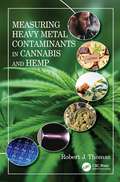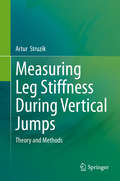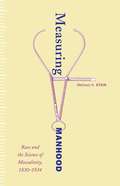- Table View
- List View
Measurements for Terrestrial Vegetation
by Charles D. BonhamMeasurements for Terrestrial Vegetation, 2nd Edition presents up-to-date methods for analyzing species frequency, plant cover, density and biomass data. Each method is presented in detail with a full discussion of its strengths and weaknesses from field applications through statistical characteristics of bias and use of the correct probability distribution to describe and analyze data. This practical book also covers the use of satellite imagery to obtain measurement data on cover, density and biomass. Field data collection includes current applications of statistical sampling and analysis designs that should be used to obtain and analyze these data. This new and thoroughly updated edition of a classic text will be essential reading for everyone involved in measuring and assessing vegetation and plant biomass, including researchers and practitioners in vegetation science, plant ecology, forestry, global change scientists and conservation scientists. Provides a comprehensive catalogue of sampling, surveying and measuring techniques in vegetation scienceUpdated to include new technologies and developments in the fieldNew coverage of prediction models for large areas, including satellite mapping and remote sensing techniquesIncludes up-to-date applications of statistical sampling and analysis designs used to obtain and analyse data Reviews the strengths and weaknesses of each technique, allowing an informed choice of alternative approachesClear diagrams to explain best-practice in methodology The companion website for this book can be found at www.wiley.com/go/bonham/measurements
Measurements in Musculoskeletal Radiology (Medical Radiology)
by A. Mark Davies Victor N. Cassar-PullicinoThis practical, comprehensive book provides succinct and up-to-date information on the value of the various diagnostic radiological measurements made using all the imaging modalities currently employed in the management of a wide spectrum of musculoskeletal disorders. The book has a unique design, with three distinct but dove-tailed sections. All chapters are written by experts in the field, drawn from across Europe, and the book is lavishly illustrated throughout.
Measurements of Higgs Boson Properties in Proton-Proton Collisions at √s =7, 8 and 13 TeV at the CERN Large Hadron Collider (Springer Theses)
by Ulascan SaricaThis thesis documents the measurement of lifetime, width, mass, and couplings to two electroweak bosons of the recently-discovered Higgs boson using data from the CMS experiment at the Large Hadron Collider. Both on-shell (at the mass of around 125 GeV) and off-shell (above 200 GeV) Higgs boson production is studied and an excess of off-shell production with significance above two standard deviations is observed for the first time. The latter is a qualitative new way to study the Higgs field, responsible for generation of mass of all the known elementary particles. In addition, phenomenological tools have been developed with the Monte Carlo event generator and matrix element techniques for an optional analysis of LHC data. Optimization of the CMS data with careful alignment of the silicon tracker is also presented.
Measurements of Phosphor Properties
by William M. Yen Shigeo Shionoya Hajime YamamotoMeasuring the properties of phosphors is an essential step in developing and selecting phosphors for specific applications. Consisting of chapters drawn from the second edition of the best-selling Handbook of Phosphors, Measurements of Phosphor Properties outlines various methods for characterizing and measuring the optical and luminescence properties of phosphors. The book covers measurement in the vacuum-ultraviolet region, measurement of particle size and optical properties of phosphor powders, and relevant aspects of color vision in the human eye. It details the optical properties of powder layers, color vision, and other miscellanies. It concludes with a detailed history of phosphor technology and industry.
Measurements of Spin-Orbit Angles for Transiting Systems
by Teruyuki HiranoThis thesis presents accurate analyses of the spin-orbit angle for many remarkable transiting exoplanetary systems, including the first measurement of the Rossiter-McLaughlin effect for a multiple transiting system. The author presents the observational methods needed to probe the spin-orbit angle, the relation between the stellar spin axis and planetary orbital axis. Measurements of the spin-orbit angle provide us a unique and valuable opportunity to understand the origin of close-in giant exoplanets, called "hot Jupiters". The first method introduced involves observations of the Rossiter-McLaughlin effect (RM effect). The author points out the issues with the previous theoretical modeling of the RM effect and derives a new and improved theory. Applications of the new theory to observational data are also presented for a number of remarkable systems, and the author shows that the new theory minimizes the systematic errors by applying it to the observational data. The author also describes another method for constraining the spin-orbit angle: by combining the measurements of stellar flux variations due to dark spots on the stellar surface, with the projected stellar rotational velocity measured via spectroscopy, the spin-orbit angles "along the line-of-sight" are constrained for the transiting exoplanetary systems reported by the Kepler space telescope.
Measurements of the X c and X b Quarkonium States in pp Collisions with the ATLAS Experiment
by Andrew ChisholmThis thesis, which won one of the six 2015 ATLAS Thesis Awards, concerns the study of the charmonium and bottomonium bound heavy quark bound states. The first section of the thesis describes the observation of a candidate for the chi_b(3P) bottomonium states. This represented the first observation of a new particle at the LHC and its existence was subsequently confirmed by D0 and LHCb experiments. The second part of the thesis presents measurements of the prompt and non-prompt production of the chi_c1 and chi_c2 charmonium states in proton-proton collisions. These measurements are compared to several theoretical predictions and can be used to inform the development of theoretical models of quarkonium production.
Measurements using Optic and RF Waves
by Pierre-Noël Favennec Frédérique De FornelScientific and technical knowledge for measurements in modern electromagnetism must be vast as our electromagnetic environment covers all frequencies and wavelengths. These measurements must be applied to fields as varied as nanotechnologies, telecommunications, meteorology, geolocalization, radioastronomy, health, biology, etc. In order to cover the multiple facets of the topic, this book sweeps the entire electromagnetic spectrum, from several hertz to terahertz; considers distances ranging from nanometers to light-years in optics; before extending towards the various measurement techniques using electromagnetic waves for various applications. This book describes these different facets in eleven chapters, each covering different domains of applications.
Measures of Environmental Performance and Ecosystem Condition
by National Academy of EngineeringWhen Cleveland's Cuyahoga River caught fire in 1969, no environmental measurements were necessary to know the seriousness of the problem. Incidents like the Cuyahoga fire raise an important question: Can catastrophes-in-the-making be detected early enough to be prevented? For those in industry, such disasters point to the need for measures that can improve the environmental performance of processes, products, business practices, and linked industrial systems.In Measures of Environmental Performance and Ecosystem Condition, experts share their insights on environmental metrics. The volume explores the most productive relationship between measures of environmental performance and measures of ecosystem conditions. It reviews current approaches, evaluates structures for business decisionmaking, and includes a matrix for determining the environmental performance of industrial facilities. Case studies include: Development and application of a water-quality rating scheme for streams and reservoirs in the Tennessee Valley. Three years of successful experience with waste metrics at 3M. The book covers the range of environmental performance and condition metrics, from the use of material flow data to monitor environmental performance at the national level to the use of bioassays to measure the toxicity of industrial effluents.This book offers something for everyone--policymakers, executives, engineers, managers, and advocates--with a stake in the measurement of environmental performance and ecological conditions.
Measures, Integrals and Martingales
by René L. SchillingThis is a concise and elementary introduction to contemporary measure and integration theory as it is needed in many parts of analysis and probability theory. Undergraduate calculus and an introductory course on rigorous analysis in R are the only essential prerequisites, making the text suitable for both lecture courses and for self-study. Numerous illustrations and exercises are included to consolidate what has already been learned and to discover variants and extensions to the main material. Hints and solutions can be found on the authors website, which can be reached at http://www.motapa.de/measures_integrals_and_martingales/index.html
Measuring America: How the United States Was Shaped by the Greatest Land Sale in History
by Andro Linklater(abbreviated from back cover)In 1790,... America's debt was enormous, Before the nation's greatest asset-the land west of the Ohio River-could be sold, it had to be measured out and mapped. This book tells the fascinating story of how we ultimately gained the American Customary System-the last traditional system m the world-and how one man's surveying chain indelibly imprinted its dimensions on the land, and our culture from coast to coast.
Measuring Arthropod Biodiversity: A Handbook of Sampling Methods
by Geraldo Wilson Fernandes Jean Carlos SantosThis book brings together a wide range of sampling methods for investigating different arthropod groups. Each chapter is organised to describe and evaluate the main sampling methods (field methods, materials and supplies, sampling protocols, effort needed, and limitations); in addition, some chapters describe the specimen preparation and conservation, species identification, data collection and management (treatment, statistical analysis, interpretation), and ecological/conservation implications of arthropod communities. The book aims to be a reference for zoologists, entomologists, arachnologists, ecologists, students, researchers, and for those interested in arthropod science and biodiversity. We hope the book will contribute to advance knowledge on field assessments and conservation strategies. Arthropods represent the most speciose group of organisms on Earth, with a remarkable number of species and interactions still to be described. These invertebrates are recognized for playing key ecological roles in terrestrial, freshwater and marine ecosystems. Because of the increasing and relentless threats arthropods are facing lately due to a multitude of human induced drivers, this book represents an important contribution to assess their biodiversity and role in ecosystem functioning and generation of ecosystem services worldwide.
Measuring Behaviour: An Introductory Guide
by Paul Martin Melissa BatesonMeasuring Behaviour is the established go-to text for anyone interested in scientific methods for studying the behaviour of animals or humans. It is widely used by students, teachers and researchers in a variety of fields, including biology, psychology, the social sciences and medicine. This new fourth edition has been completely rewritten and reorganised to reflect major developments in how behavioural studies are conducted. It includes new sections on the replication crisis, covering Open Science initiatives such as preregistration, as well as fully up-to-date information on the use of remote sensors, big data and artificial intelligence in capturing and analysing behaviour. The sections on the analysis and interpretation of data have been rewritten to align with current practices, with advice on avoiding common pitfalls. Although fully revised and revamped, this new edition retains the simplicity, clarity and conciseness that have made Measuring Behaviour a classic since the first edition appeared more than 30 years ago.
Measuring Biological Diversity
by Anne E. MagurranThis accessible and timely book provides a comprehensive overview of how to measure biodiversity. The book highlights new developments, including innovative approaches to measuring taxonomic distinctness and estimating species richness, and evaluates these alongside traditional methods such as species abundance distributions, and diversity and evenness statistics. Helps the reader quantify and interpret patterns of ecological diversity, focusing on the measurement and estimation of species richness and abundance. Explores the concept of ecological diversity, bringing new perspectives to a field beset by contradictory views and advice.
Measuring Biological Impacts of Nanomaterials
by Joachim WegenerThis book reviews several aspects of the biological response to nanoscale particles on a molecular and cellular level. Nanoscale materials and nanoscale particles in particular have interesting properties and beneficial applications. While they thus have entered our daily lifes on many different levels (from electronics, over textiles, packaging or surface modifications, to biomedical applications), general rules describing their interaction with biological structures and biological matter are still difficult to derive. The existing literature suggests a variety of interaction schemes between nanoparticles and biological objects, not dispelling the public concerns about possible health effects and harmful properties. A systematic approach to the problem is needed and timely. This book specifically emphasizes bioanalytical problems starting from the characterization of the nanomaterials to the pitfalls and potential artifacts of state-of-the-art cytotoxicity assays that are frequently used to study harmful effects on cells. It also highlights the application of label-free bioanalytical techniques that can potentially complement the present approaches and hence provide new perspectives on this highly discussed cutting-edge field of research and public concern.
Measuring Cerebellar Function (Neuromethods #177)
by Roy V. SillitoeThis volume considers the current techniques used by experts to study and measure cerebellar function. The chapters in this book cover topics such as stem cell-based techniques; conditional genetics approaches in model systems; neuronal recordings conducted in vitro and in vivo; and an ever-growing list of behavioral paradigms. This book also provides readers with a guide for how to use tools such as iPSCs and how to address questions using a range of approaches in animal model systems including mouse, rat, zebrafish, and non-human primate. In the Neuromethods series style, the chapters include the kind of detail and key advice from the specialists needed to get successful results in your laboratory.Cutting-edge and authoritative, Measuring Cerebellar Function is a valuable resource for cerebellar enthusiasts and other scientists interested in learning more about the cerebellum and the technological advances that are currently being employed to unlock brain function and understand animal behavior.
Measuring Climate Change to Inform Energy Transitions: Carbon Footprint Calculations
by Sunny E. IyukeMeasuring Climate Change to Inform Energy Transitions A useful assessment tool to inform energy transition decisions in view of climate change Climate change is without question the greatest global challenge of the twenty-first century. Among its many aspects is the need for energy transitions worldwide, as sustainable energy infrastructure must be rapidly created if the world is to forestall climate catastrophe. Methods for measuring CO2 concentration and other factors producing climate change will be critical to managing this transition and assessing its early impacts. Measuring Climate Change to Inform Energy Transitions proposes a method for measuring sinusoidal gradients of increasing temperatures and CO2 concentration in order to determine the ongoing impact of global warming and make recommendations. This method will be critical in informing key decisions as the energy transition proceeds. It is a must-read for academic, professional, and policy stakeholders looking to meet these challenges head-on. Readers will also find: Concrete models and mechanisms for effecting energy transition Detailed discussion of topics including vegetative sinks for carbon capture, power reforms from coal, carbon footprint of internal combustion engines, skills required for green jobs and many more Examples and case studies to supplement quantitative analyses This book is ideal for professionals, undergraduate and graduate students, and researchers in the energy, environmental, government, and engineering fields.
Measuring Crime: Behind the Statistics (ASA-CRC Series on Statistical Reasoning in Science and Society)
by Sharon L. LohrCrime statistics are everywhere, but how do you know when they’re valid? If a newspaper report says "the rate of overall violent crime decreased by 0.9 percent," how can you tell where that statistic came from, what it measures, and how accurate it is? Is it worth repeating or sharing? Measuring Crime: Behind the Statistics gives you the tools to interpret and evaluate crime statistics’ quality and usefulness. The book focuses on ways of thinking about crime statistics (no formulas!) and features Eight questions you should ask before quoting a statistic The two sources of information about homicide FBI statistics: what do they measure? How victimization surveys can reflect your experiences even though you were not asked to participate Special considerations when interpreting statistics about sexual assault and fraud Examples of experiments and studies on how to improve crime statistics Two online supplements containing additional details and links to data sources Whether you are a law enforcement professional, journalist, student, or interested citizen, Measuring Crime: Behind the Statistics will tell you how to read statistics as a statistician would. Sharon Lohr, the author of Sampling: Design and Analysis, has published widely about statistical methods for education, public policy, law, and crime. She has been recognized as Fellow of the American Statistical Association, elected member of the International Statistical Institute, and recipient of the Gertrude M. Cox Statistics Award and the Deming Lecturer Award. Formerly Dean’s Distinguished Professor of Statistics at Arizona State University and a Vice President at Westat, she is now a freelance statistical consultant and writer. Visit her website at www.sharonlohr.com. "The book aims to achieve two goals: introduce statistical ideas to a general audience and provide an overview of US crime statistics. These are disparate topics, but in the way they are approached here, there is a strong synergy that reinforces both aspects. One the one hand, the reader's natural curiosity about crime (what is it, how are crime events classified and reported, how reliable are the numbers you see in the newspaper, etc.) will help him/her become interested in the statistical issues and learn these concepts in a practical and concrete setting. And on the other hand, by reading about the statistical issues surrounding crime data, he/she gains a better appreciation for the complexities of crime statistics, eventually acquiring a deeper understanding of them. As a statistician myself, I learned interesting facts about the types of crime, their nomenclature and the possible confusion surrounding them, and how the data are collected and reported. Overall, I think the combination is effective and very well developed in this book." (Jean Opsomer, Westat) "This book is an excellent primer on handling the mass of data and information researchers are faced with. While it is geared toward followers of criminal justice information, much of the book is a very good introduction to survey techniques discussing their strong and weak points. Most importantly, there are very good guidelines and questions that one should employ before citing any data or using data for policy decisions or for reporting on data such as journalists do. The book is written in a non-technical manner and does a very good job of explaining the nuances in reviewing data. Any researcher who utilizes data would find this valuable. While it has specific examples in the criminal justice field, it really is quite useful for any user of data." (Barry Nussbaum, former President American Statistical Association)
Measuring Elemental Impurities in Pharmaceuticals: A Practical Guide (Practical Spectroscopy)
by Robert ThomasRecent regulations on heavy metal testing have required the pharmaceutical industry to monitor a suite of elemental impurities in pharmaceutical raw materials, drug products and dietary supplements. These new directives s are described in the new United States Pharmacopeia (USP) Chapters , , and , together with Q3D, Step 4 guidelines for elemental impurities, drafted by the ICH (International Conference on Harmonization of Technical Requirements for Registration of Pharmaceuticals for Human Use), a consortium of global pharmaceutical associations, including the European Pharmacopeia (Ph.Eur.), the Japanese Pharmacopeia (JP) and the USP. This book provides a complete guide to the analytical methodology, instrumental techniques and sample preparation procedures used for measuring elemental impurities in pharmaceutical and nutraceutical materials. It offers readers the tools to better understand plasma spectrochemistry to optimize detection capability for the full suite of elemental PDE (Permitted Daily Exposure) levels in the various drug delivery categories. Other relevant information covered in the book includes: The complete guide to measuring elemental impurities in pharmaceutical and nutraceutical materials. Covers heavy metals testing in the pharmaceutical industry from an historical perspective. Gives an overview of current USP Chapters and and ICH Q3D Step 4 Guidelines. Explains the purpose of validation protocols used in Chapter , including how J-values are calculated Describes fundamental principles and practical capabilities of ICP-MS and ICP-OES. Offers guidelines about the optimum strategy for risk assessment Provides tips on how best to prepare and present your data for regulatory inspection. An indispensable resource, the fundamental principles and practical benefits of ICP-OES and ICP-MS are covered in a reader-friendly format that a novice, who is carrying out elemental impurities testing in the pharmaceutical and nutraceutical communities, will find easy to understand.
Measuring Emission of Agricultural Greenhouse Gases and Developing Mitigation Options using Nuclear and Related Techniques: Applications of Nuclear Techniques for GHGs
by Christoph Müller Lee Heng Mohammad ZamanThis open access book is an outcome of the collaboration between the Soil and Water Management & Crop Nutrition Section, Joint FAO/IAEA Division of Nuclear Techniques in Food and Agriculture, Department of Nuclear Sciences and Applications, International Atomic Energy Agency (IAEA), Vienna, Austria, and the German Science Foundation research unit DASIM (Denitrification in Agricultural Soils: Integrated control and Modelling at various scales) and other institutes. It presents protocols, methodologies and standard operating procedures (SOPs) for measuring GHGs from different agroecosystems and animals using isotopic and related techniques that can also be used to validate climate-smart agricultural practices to mitigate GHGs. The material featured is useful for beginners in the field wanting an overview of the current methodologies, but also for experts who need hands-on descriptions of said methodologies. The book is written in form of a monograph and consists of eight chapters.
Measuring Eternity
by Martin GorstThe untold story of the religious figures, philosophers, astronomers, geologists, physicists, and mathematicians who, for more than four hundred years, have pursued the answer to a fundamental question at the intersection of science and religion: When did the universe begin? The moment of the universe's conception is one of science's Holy Grails, investigated by some of the most brilliant and inquisitive minds across the ages. Few were more committed than Bishop James Ussher, who lost his sight during the fifty years it took him to compose his Annals of all known history, now famous only for one date: 4004 b.c. Ussher's date for the creation of the world was spectacularly inaccurate, but that didn't stop it from being so widely accepted that it was printed in early twentieth-century Bibles. As writer and documentary filmmaker Martin Gorst vividly illustrates in this captivating, character-driven narrative, theology let Ussher down just as it had thwarted Theophilus of Antioch and many before him. Geology was next to fail the test of time. In the eighteenth century, naturalist Comte de Buffon, working out the rate at which the earth was supposed to have cooled, came up with an age of 74,832 years, even though he suspected this was far too low. Biology then had a go in the hands of fossil hunter Johann Scheuchzer, who alleged to have found a specimen of a man drowned at the time of Noah's flood. Regrettably it was only the imprint of a large salamander. And so science inched forward via Darwinism, thermodynamics, radioactivity, and, most recently, the astronomers at the controls of the Hubble space telescope, who put the beginning of time at 13.4 billion years ago (give or take a billion). Taking the reader into the laboratories and salons of scholars and scientists, visionaries and eccentrics, Measuring Eternity is an engagingly written account of an epic, often quixotic quest, of how individuals who dedicated their lives to solving an enduring mystery advanced our knowledge of the universe.From the Hardcover edition.
Measuring Fundamental Symmetry Violation in Polyatomic Molecules (Springer Theses)
by Arian JadbabaieThis thesis presents major advances toward the realization of quantum control in complex molecules for applications in precision metrology. Polyatomic molecules engineered to be sensitive to new fundamental particles and forces are a powerful platform to search for physics beyond the Standard Model. A major limitation to this application, as well as any other relying on the complete quantum control of complex polyatomic molecules, is that fully understanding them remains a research frontier. This thesis represents several major steps toward the goal of quantum control in complex molecules, including tailored laser-driven chemistry to enhance their production, high-resolution spectroscopy to understand their structure, including the critical role of symmetry, and successful implementation of coherent quantum control. This thesis lays the foundation for fundamental studies in nuclear physics, particle physics, and physical chemistry using engineered, quantum-controlled molecules.
Measuring Gene Expression (THE BASICS (Garland Science))
by Matthew AvisonIn the post-genomic age, much biomedical research looks at when, where, and at what level genes are expressed. Measuring Gene Expression is an all-in-one introduction to the main methods of measuring gene expression, including RT-PCR, differential display, RNA interference, reporter genes, microarrays, and proteomics, as well as a section on RNA isolation and analysis. There is an overview of each method: its pros and cons, sample preparation, sources of error, and data interpretation.
Measuring Heavy Metal Contaminants in Cannabis and Hemp
by Robert J. ThomasThe surge of interest in cannabis-based medicinal products has put an extremely high demand on testing capabilities, particularly for contaminants such as heavy metals, which are naturally taken up through the roots of the plants from the soil, growing medium, and fertilizers but can also be negatively impacted by the grinding equipment and extraction/distillation process. Unfortunately, many state regulators do not have the necessary experience and background to fully understand all the safety and toxicological issues regarding the cultivation and production of cannabis and hemp products on the market today. Measuring Heavy Metal Contaminants in Cannabis and Hemp offers a comprehensive guide to the entire cannabis industry for measuring elemental contaminants in cannabis and hemp. For testing labs, it describes fundamental principles and practical capabilities of ICP-MS and other AS techniques for measuring heavy metals in cannabis. For state regulators, it compares maximum contaminant limits of heavy metals with those for federally regulated pharmaceutical materials. For cultivators and processors, it helps them to better understand the many sources of heavy metals in cannabis. And for consumers of medical cannabis, it highlights the importance of choosing cannabis products that are safe to use. Other key topics include: The role of other analytical techniques for the comprehensive testing of cannabis products Tips to optimize analytical procedures to ensure the highest quality data Guidance on how to characterize elemental contaminants in vaping liquids and aerosols Suggestions on how to reduce errors using plasma spectrochemistry The role of certified reference materials to validate standard methods Easy-to-read sections on instrumental hardware components, calibration and measurement protocols, typical interferences, routine maintenance, and troubleshooting procedures Written with the cannabis testing community in mind, this book is also an invaluable resource for growers, cultivators, processors, testers, regulators, and even consumers who are interested in learning more about the potential dangers of heavy metal contaminants in cannabis and hemp.
Measuring Leg Stiffness During Vertical Jumps: Theory and Methods
by Artur StruzikThis book presents a thorough description and critical discussion of different approaches to measuring leg stiffness during vertical jumps, as well as practical applications. Various topics covered include the applicability of the spring-mass (linear) model of the human motion system, leg stiffness controversies and interpretations, and computational and measuring methods of leg stiffness during vertical jumps. Additionally, a description of a research project performed expressly for inclusion in this book is given; the study aims to determine normative values for leg stiffness for young, healthy, non-athletes during single vertical jumps to maximal and specific heights. A final chapter covers additional perspectives, enabling the reader to acquire different perspectives on measuring leg stiffness during vertical jumps across a breadth of information and interpretations.Measuring Leg Stiffness During Vertical Jumps: Theory and Methods is an ideal book for researchers and practitioners in the fields of biomedical engineering, biomechanics, and sport sciences.
Measuring Manhood: Race and the Science of Masculinity, 1830–1934
by Melissa N. SteinFrom the &“gay gene&” to the &“female brain&” and African American students&’ insufficient &“hereditary background&” for higher education, arguments about a biological basis for human difference have reemerged in the twenty-first century. Measuring Manhood shows where they got their start.Melissa N. Stein analyzes how race became the purview of science in nineteenth- and early twentieth-century America and how it was constructed as a biological phenomenon with far-reaching social, cultural, and political resonances. She tells of scientific &“experts&” who advised the nation on its most pressing issues and exposes their use of gender and sex differences to conceptualize or buttress their claims about racial difference. Stein examines the works of scientists and scholars from medicine, biology, ethnology, and other fields to trace how their conclusions about human difference did no less than to legitimize sociopolitical hierarchy in the United States.Covering a wide range of historical actors from Samuel Morton, the infamous collector and measurer of skulls in the 1830s, to NAACP leader and antilynching activist Walter White in the 1930s, this book reveals the role of gender, sex, and sexuality in the scientific making?and unmaking?of race.
